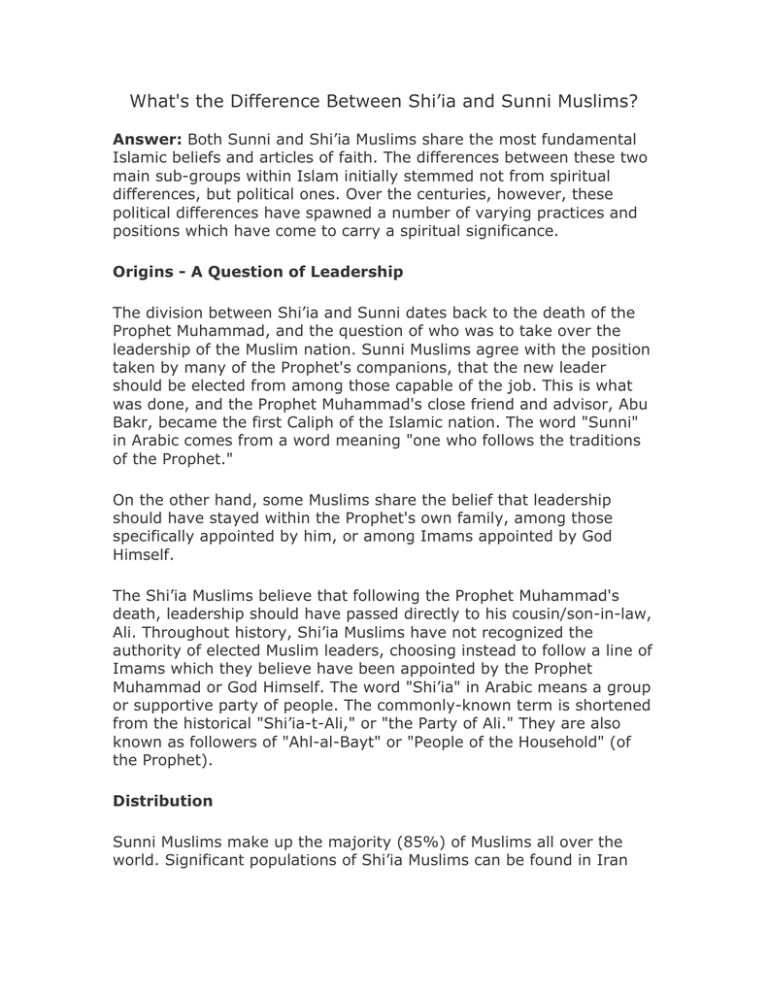What's the Difference Between Shi’ia and Sunni Muslims?
advertisement

What's the Difference Between Shi’ia and Sunni Muslims? Answer: Both Sunni and Shi’ia Muslims share the most fundamental Islamic beliefs and articles of faith. The differences between these two main sub-groups within Islam initially stemmed not from spiritual differences, but political ones. Over the centuries, however, these political differences have spawned a number of varying practices and positions which have come to carry a spiritual significance. Origins - A Question of Leadership The division between Shi’ia and Sunni dates back to the death of the Prophet Muhammad, and the question of who was to take over the leadership of the Muslim nation. Sunni Muslims agree with the position taken by many of the Prophet's companions, that the new leader should be elected from among those capable of the job. This is what was done, and the Prophet Muhammad's close friend and advisor, Abu Bakr, became the first Caliph of the Islamic nation. The word "Sunni" in Arabic comes from a word meaning "one who follows the traditions of the Prophet." On the other hand, some Muslims share the belief that leadership should have stayed within the Prophet's own family, among those specifically appointed by him, or among Imams appointed by God Himself. The Shi’ia Muslims believe that following the Prophet Muhammad's death, leadership should have passed directly to his cousin/son-in-law, Ali. Throughout history, Shi’ia Muslims have not recognized the authority of elected Muslim leaders, choosing instead to follow a line of Imams which they believe have been appointed by the Prophet Muhammad or God Himself. The word "Shi’ia" in Arabic means a group or supportive party of people. The commonly-known term is shortened from the historical "Shi’ia-t-Ali," or "the Party of Ali." They are also known as followers of "Ahl-al-Bayt" or "People of the Household" (of the Prophet). Distribution Sunni Muslims make up the majority (85%) of Muslims all over the world. Significant populations of Shi’ia Muslims can be found in Iran and Iraq, and large minority communities in Yemen, Bahrain, Syria, and Lebanon. Differences in Religious Practice From this initial question of political leadership, some aspects of spiritual life have been affected and now differ between the two groups of Muslims. It is important to remember that despite these differences in opinion and practice, Shi’ia and Sunni Muslims share the main articles of Islamic belief and are considered by most to be brethren in faith. In fact, most Muslims do not distinguish themselves by claiming membership in any particular group, but prefer to call themselves simply, "Muslims." Religious Leadership Shi’ia Muslims believe that the Imam is sinless by nature, and that his authority is infallible as it comes directly from God. Therefore, Shi’ia Muslims often venerate the Imams as saints and perform pilgrimages to their tombs and shrines in the hopes of divine intercession. Sunni Muslims counter that there is no basis in Islam for a hereditary privileged class of spiritual leaders, and certainly no basis for the veneration or intercession of saints. Sunni Muslims contend that leadership of the community is not a birthright, but a trust that is earned and which may be given or taken away by the people themselves. Religious Texts and Practices Shi’ia Muslims also feel animosity towards some of the companions of the Prophet Muhammad, based on their positions and actions during the early years of discord about leadership in the community. Many of these companions (Abu Bakr, Umar, Aisha, etc.) have narrated traditions about the Prophet's life and spiritual practice. Shi’ia Muslims reject these traditions (hadith) and do not base any of their religious practices on the testimony of these individuals. This naturally gives rise to some differences in religious practice between the two groups. These differences touch all detailed aspects of religious life: prayer, fasting, pilgrimage, etc.








